人教版(2019)必修 第一册Unit 3 Sports and fitness Discovering Useful Structure 课件 (共28张PPT)
文档属性
| 名称 | 人教版(2019)必修 第一册Unit 3 Sports and fitness Discovering Useful Structure 课件 (共28张PPT) | 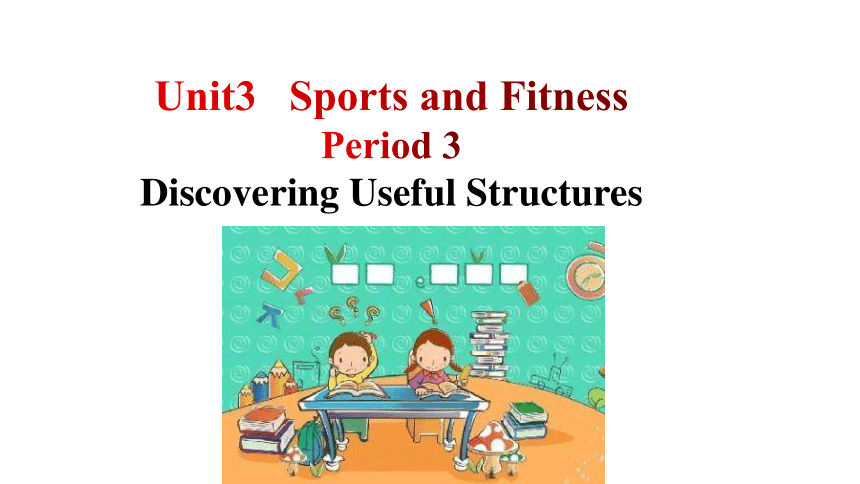 | |
| 格式 | pptx | ||
| 文件大小 | 2.3MB | ||
| 资源类型 | 教案 | ||
| 版本资源 | 人教版(2019) | ||
| 科目 | 英语 | ||
| 更新时间 | 2024-07-23 22:50:15 | ||
图片预览

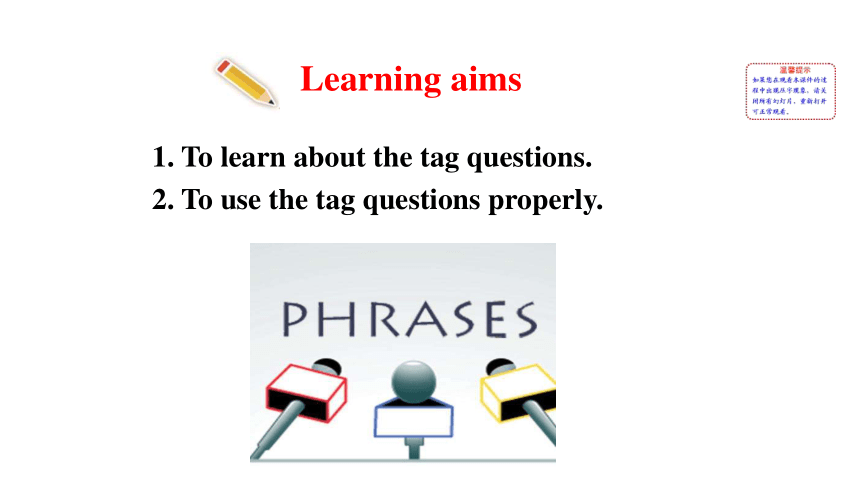
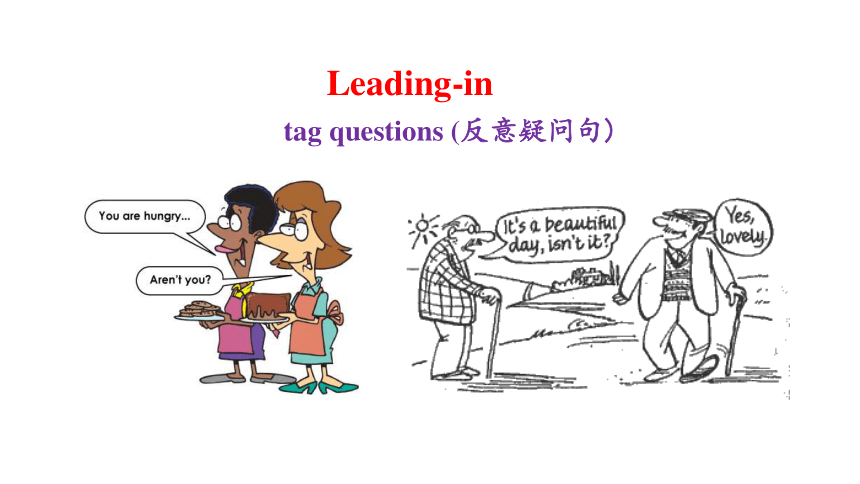
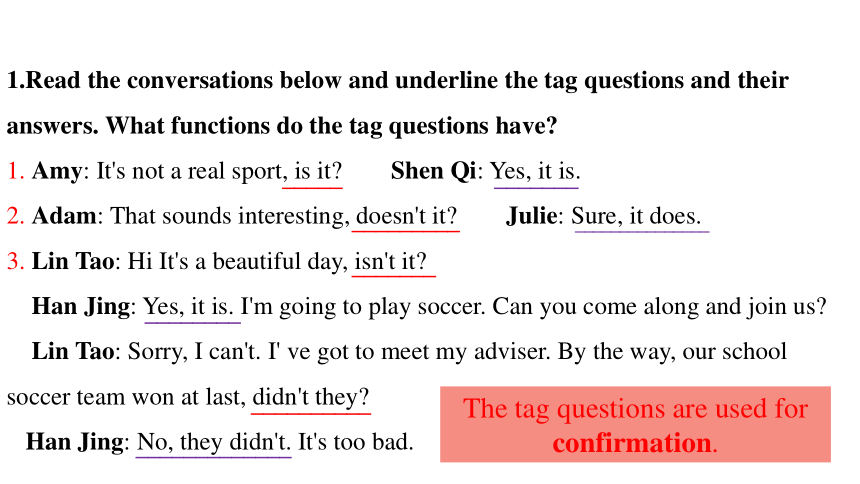
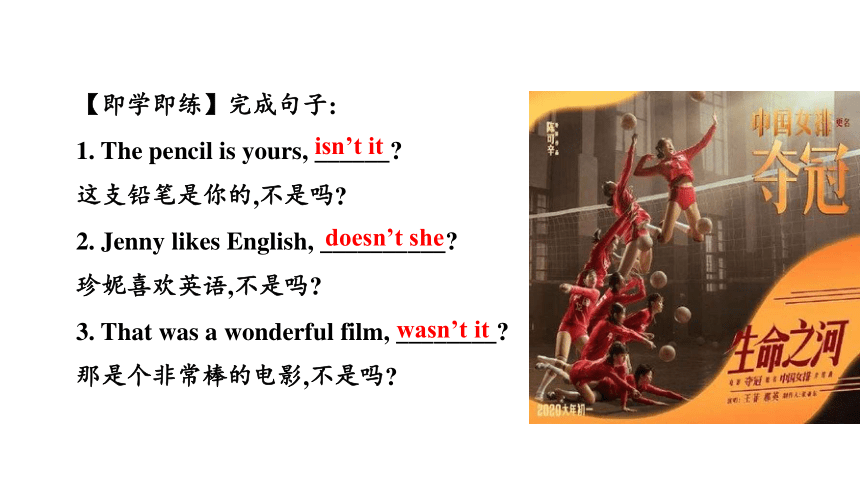
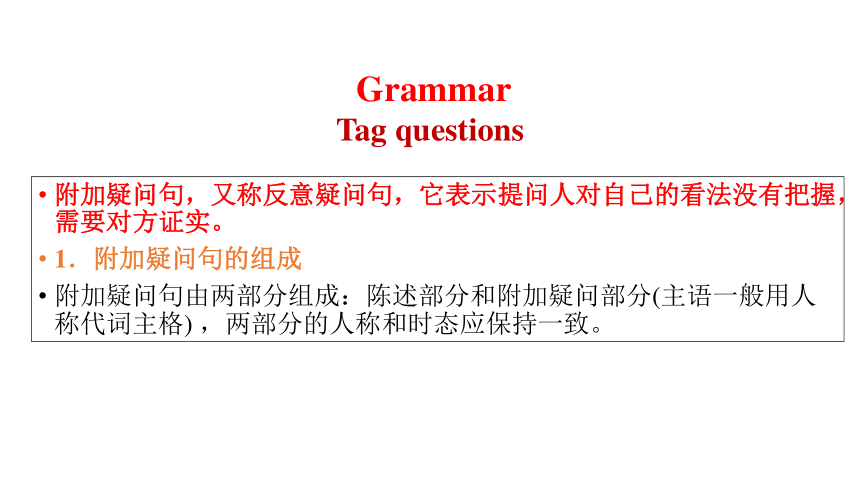
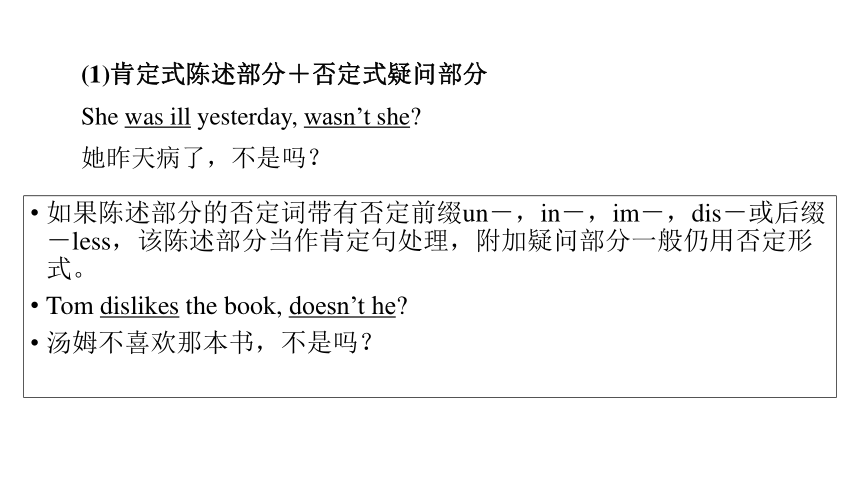
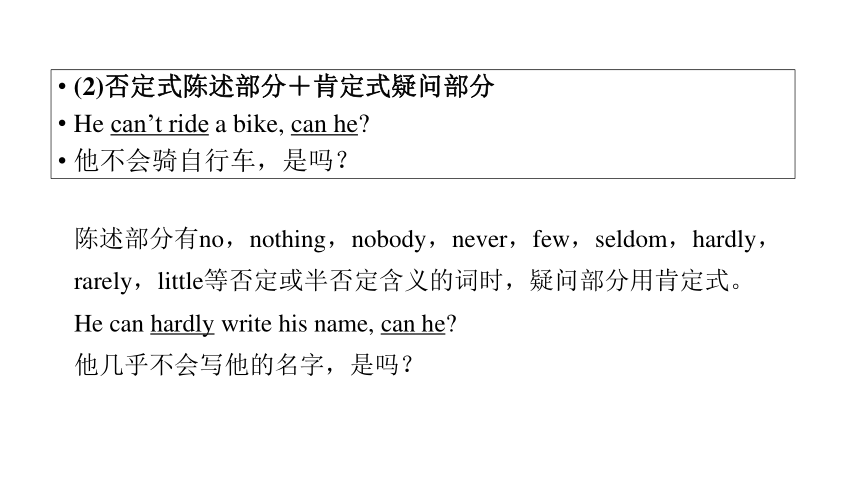
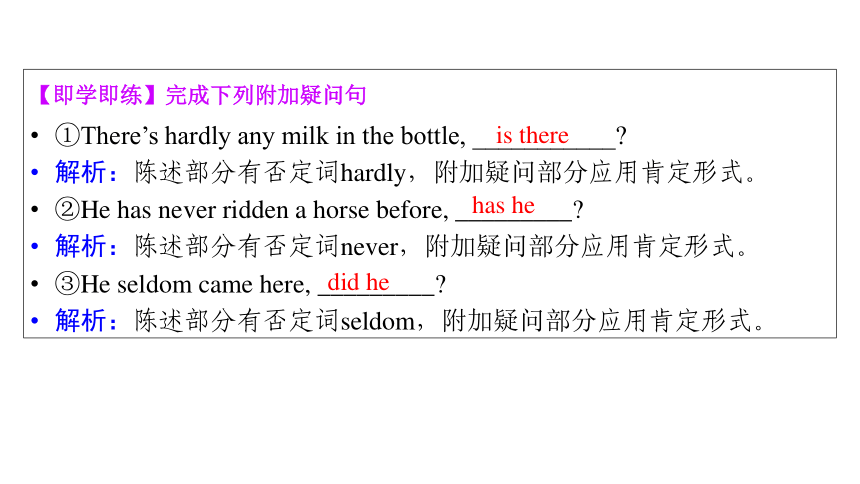
文档简介
(共28张PPT)
Unit3 Sports and Fitness
Period 3
Discovering Useful Structures
1. To learn about the tag questions.
2. To use the tag questions properly.
Learning aims
tag questions (反意疑问句)
Leading-in
1.Read the conversations below and underline the tag questions and their answers. What functions do the tag questions have
1. Amy: It's not a real sport, is it Shen Qi: Yes, it is.
2. Adam: That sounds interesting, doesn't it Julie: Sure, it does.
3. Lin Tao: Hi It's a beautiful day, isn't it
Han Jing: Yes, it is. I'm going to play soccer. Can you come along and join us
Lin Tao: Sorry, I can't. I' ve got to meet my adviser. By the way, our school soccer team won at last, didn't they
Han Jing: No, they didn't. It's too bad.
_____
_______
_________
_______________
_______
________
__________
_____________
The tag questions are used for confirmation.
【即学即练】完成句子:
1. The pencil is yours, ______
这支铅笔是你的,不是吗
2. Jenny likes English, __________
珍妮喜欢英语,不是吗
3. That was a wonderful film, ________
那是个非常棒的电影,不是吗
isn’t it
doesn’t she
wasn’t it
附加疑问句,又称反意疑问句,它表示提问人对自己的看法没有把握,需要对方证实。
1.附加疑问句的组成
附加疑问句由两部分组成:陈述部分和附加疑问部分(主语一般用人称代词主格) ,两部分的人称和时态应保持一致。
Grammar
Tag questions
如果陈述部分的否定词带有否定前缀un-,in-,im-,dis-或后缀-less,该陈述部分当作肯定句处理,附加疑问部分一般仍用否定形式。
Tom dislikes the book, doesn’t he
汤姆不喜欢那本书,不是吗?
(1)肯定式陈述部分+否定式疑问部分
She was ill yesterday, wasn’t she
她昨天病了,不是吗?
(2)否定式陈述部分+肯定式疑问部分
He can’t ride a bike, can he
他不会骑自行车,是吗?
陈述部分有no,nothing,nobody,never,few,seldom,hardly,
rarely,little等否定或半否定含义的词时,疑问部分用肯定式。
He can hardly write his name, can he
他几乎不会写他的名字,是吗?
【即学即练】完成下列附加疑问句
①There’s hardly any milk in the bottle, ___________
解析:陈述部分有否定词hardly,附加疑问部分应用肯定形式。
②He has never ridden a horse before, _________
解析:陈述部分有否定词never,附加疑问部分应用肯定形式。
③He seldom came here, _________
解析:陈述部分有否定词seldom,附加疑问部分应用肯定形式。
is there
has he
did he
④He disagrees with his parents, ______________
解析:陈述部分的否定词disagrees带有否定前缀dis-,该陈述部分作肯定处理,附加疑问部分仍用否定形式。
⑤These tools are useless now, _______________
解析:陈述部分的否定词useless带有否定后缀-less,该陈述部分作肯定处理,附加疑问部分仍用否定形式。
⑥You’ve never visited the Great Wall, ___________
解析:陈述部分有否定词never,附加疑问部分应用肯定形式。
doesn’t he
aren’t they
have you
2.附加疑问句的回答
(1)当陈述句部分是肯定结构,附加疑问句部分用否定式提问时,如果事实是肯定的,就用yes,事实是否定的,就要用no。
—He likes playing football, doesn’t he
他喜欢踢足球,不是吗?
—Yes,he does./No,he doesn’t.
是的,他喜欢。/不是,他不喜欢。
(2)当陈述句部分是否定结构,附加疑问句部分用肯定式提问时,回答yes或no与汉语的意思正好相反。这种回答的yes要译成“不”,no要译成“是”。
—His sister didn’t attend the meeting, did she
他妹妹没有参加会议,是吗?
—Yes,she did./No,she didn’t.
不,她参加了。/是的,她没参加。
【即学即练】根据句意补全句子
①—You’ve never seen dinosaur eggs, have you
—_________________.How I wish to visit the Dinosaur World.
解析:根据How I wish to visit the Dinosaur World.“我多么希望参观恐龙世界”可知没有看过恐龙蛋,故应该用“No, I haven’t.”来回答,意为“是的,我没有看过”。
No, I haven’t
②—They don’t work hard, do they
—_______________.They are the most hardworking students in our class.
解析:根据They are the most hard-working students in our class.可知他们学习最努力,故应该用“Yes, they do.”来回答,意为“不,他们很努力”。
Yes, they do
3.主语的选择
陈述部分主语和附加部分主语在人称和数量上保持一致的几种情况:
陈述部分主语 附加问句主语 例句
one(泛指人) one/he/you One can’t be too careful, can one/he/you
一个人要再三小心, 对吗?
this,that,非谓语形式 it That isn’t correct, is it
那不对,是吗?
Seeing is believing, isn’t it
眼见为实,不是吗?
陈述部分主语 附加问句主语 例句
these,those they These are your friends, aren’t they
这些是你的朋友,不是吗?
everything,anything, something,nothing it Nothing happened to him, did it
他没出什么事,是吗?
Everything seems all right now, doesn’t it
现在一切似乎都很好,不是吗?
everyone(body), anyone(body), someone(body), no one(nobody) he/they Nobody likes to be laughed at, does he/do they
没有人喜欢被嘲笑,是吗?
陈述部分主语 附加问句主语 例句
there be there There’s no help for it, is there
没有办法了,是吗?
主语由neither...nor...或both...and...连接 复数 Neither you nor I am wrong, are we
你我都没错,是吗?
Both you and he are doctors, aren’t you
你和他都是医生,不是吗?
【即学即练】完成下列附加疑问句
①There was a loud scream from the backstage immediately after the concert ended,
________________
解析:因为陈述部分是肯定形式,所以反意疑问部分用否定形式。陈述句为
there be结构,附加疑问句中相当于主语部分也用there。
②No one failed in the last examination, _____________
解析:因为陈述句的主语是no one,附加疑问句中的主语用they或he。
③Something has been done to stop pollution, _____________
解析:陈述句的主语是something,附加疑问句中的主语应用it。
④Somebody phoned you while I was out, _________________
解析:陈述句的主语是somebody,附加疑问句中的主语应用they或he。
wasn’t there
did they/he
didn’t they/he
hasn’t it
⑤This is very important for students, ____________
解析:陈述句的主语是this,附加疑问句中的主语应用it。
⑥Those are your books, _______________
解析:陈述句的主语是those,附加疑问句中的主语应用they。
⑦Collecting stamps is his hobby, ____________
解析:陈述句的主语是动名词短语Collecting stamps,附加疑问句中的主语应用it。
⑧To become a great writer is his dream, ____________
解析:陈述句的主语是动词不定式短语To become a great writer,附加疑问句中的主语
应用it。
⑨Neither you nor he is good at maths, __________
解析:陈述句的主语由neither...nor...连接,附加疑问句中的主语应用复数形式。
isn’t it
aren’t they
isn’t it
isn’t it
are you
4.特殊句式的附加疑问句
(1)并列句的附加疑问句的谓语遵循就近原则。
We must study hard or we can’t pass the exam, can we
我们必须努力学习,否则我们不能通过考试,对吗?
(2)宾语从句
①主句主语是第一人称,且含有think,believe,suppose,guess,expect,imagine等,疑问部分的主语和动词形式和从句一致。
We believe she can do it better, can’t she
我们相信她能做得更好,不是吗?
I don’t think he is bright, is he
我觉得他不聪明,是吗?(否定前移,疑问部分用肯定)
②主句主语是第二、三人称,疑问部分的主语和动词形式跟主句一致。
He said that he would like to visit the Great Wall, didn’t he
他说他想参观长城,不是吗?
(3)祈使句
①肯定祈使句,附加疑问句通常用will/won’t you;
否定祈使句,用will you。
Take a rest, will/won’t you
休息一下,好吗?
Don’t open the door, will you
别开门,好吗?
②Let’s引导的祈使句,附加疑问句用shall we。
Let’s go to the park, shall we
我们去公园,好吗?
③Let us引导的祈使句,附加疑问句用will you。
Let us have a look, will you
让我们看看,好吗?
④Let me引导的祈使句,附加疑问句用will you或may I。
Let me have a rest, may I/will you
让我休息一下,好吗?
(4)感叹句附加疑问句的谓语用be动词的一般现在时的否定式。
What a lucky day, isn’t it
多幸运的一天啊,不是吗?
完成下列附加疑问句
①She says that I did it,_______________
解析:含有宾语从句的主句的主语是第三人称,附加疑问句的主谓跟主句的主谓一致。故用doesn’t she。
②I guess she taught herself Japanese,______________
解析:含有宾语从句的主句的主语是第一人称,句中含有guess,附加疑问句的主谓跟宾语从句的主谓一致。故用didn’t she。
doesn’t she
didn’t she
【即学即练】
主语的选择
反意疑问句
构成
(1)肯定式陈述部分+否定式疑问部分
(2)否定式陈述部分+肯定式疑问部分
(1)当陈述句部分是肯定结构,附加疑问句部分用否定式提问时,如果事实是肯定的,就用yes,事实是否定的,就要用no。
(2)当陈述句部分是否定结构,附加疑问句部分用肯定式提问时,回答yes或no与汉语的意思正好相反。这种回答的yes要译成“不”,no要译成“是”。
(1)并列句的附加疑问句的谓语遵循就近原则。
(2)宾语从句①主句主语是第一人称,且含有think,believe,suppose,guess,
②主句主语是第二、三人称,疑问部分的主语和动词形式跟主句一致。
(3)祈使句 ①肯定祈使句,附加疑问句通常用will/won’t you;否定祈使句,用will you。
②Let’s引导的祈使句,附加疑问句用shall we。
③Let us引导的祈使句,附加疑问句用will you。
④Let me引导的祈使句,附加疑问句用will you或may I。
(4)感叹句附加疑问句的谓语用be动词的一般现在时的否定式。
特殊句式的附加疑问句
回答
Summary
Ⅰ.完成下列附加疑问句
1.You’d rather watch TV this evening,________________
2.I suppose you’re not going today,__________
3.I wish to shake hands with you,________
4.Three hours ought to be enough time,_____________________
5.They have to study a lot,______________
wouldn’t you
are you
may I
shouldn’t/oughtn’t it
don’t they
Exercise
Ⅱ.完成句子
1.I’m as tall as your sister, aren’t I
_______________(是的,你和她一样高。)
2.Tom made no answer, did he
_________________(是的,他没回答。)
3.He ought to know what to do, oughtn’t he
__________________(是的,他应该知道。)
4.Everything is ready, isn’t it
________________(不,还没准备好。)
Yes,you are.
No, he didn’t.
Yes, he ought to.
No, it isn’t.
5.The 29th Olympic Games were held in Beijing, weren’t they
_________________(是的, 是在北京。)
6.Michael Jordan started to play basketball in college, didn’t he
_________________(不,他不是。) He first played in a team in senior
high school.
7.David has been to a boxing match, hasn’t he
_________________(不,他没去过。) He always watches boxing on TV.
8.You can’t cook, can you
_____________(不,我会。) I’m good at cooking.
Yes, they were.
No, he didn’t.
No, he hasn’t.
Yes, I can.
Ⅲ.结合附加疑问句的用法补全对话
Dave:There is something wrong, 1._______________
Mike:2._______.My car is having some problems.
Dave:You want me to take a look, 3._____________
Mike:4.______,thank you.I think I can handle it.
isn’t there
Yes
don’t you
No
He that can have patience, can have what he will.
唯坚韧者始能遂其志。
Unit3 Sports and Fitness
Period 3
Discovering Useful Structures
1. To learn about the tag questions.
2. To use the tag questions properly.
Learning aims
tag questions (反意疑问句)
Leading-in
1.Read the conversations below and underline the tag questions and their answers. What functions do the tag questions have
1. Amy: It's not a real sport, is it Shen Qi: Yes, it is.
2. Adam: That sounds interesting, doesn't it Julie: Sure, it does.
3. Lin Tao: Hi It's a beautiful day, isn't it
Han Jing: Yes, it is. I'm going to play soccer. Can you come along and join us
Lin Tao: Sorry, I can't. I' ve got to meet my adviser. By the way, our school soccer team won at last, didn't they
Han Jing: No, they didn't. It's too bad.
_____
_______
_________
_______________
_______
________
__________
_____________
The tag questions are used for confirmation.
【即学即练】完成句子:
1. The pencil is yours, ______
这支铅笔是你的,不是吗
2. Jenny likes English, __________
珍妮喜欢英语,不是吗
3. That was a wonderful film, ________
那是个非常棒的电影,不是吗
isn’t it
doesn’t she
wasn’t it
附加疑问句,又称反意疑问句,它表示提问人对自己的看法没有把握,需要对方证实。
1.附加疑问句的组成
附加疑问句由两部分组成:陈述部分和附加疑问部分(主语一般用人称代词主格) ,两部分的人称和时态应保持一致。
Grammar
Tag questions
如果陈述部分的否定词带有否定前缀un-,in-,im-,dis-或后缀-less,该陈述部分当作肯定句处理,附加疑问部分一般仍用否定形式。
Tom dislikes the book, doesn’t he
汤姆不喜欢那本书,不是吗?
(1)肯定式陈述部分+否定式疑问部分
She was ill yesterday, wasn’t she
她昨天病了,不是吗?
(2)否定式陈述部分+肯定式疑问部分
He can’t ride a bike, can he
他不会骑自行车,是吗?
陈述部分有no,nothing,nobody,never,few,seldom,hardly,
rarely,little等否定或半否定含义的词时,疑问部分用肯定式。
He can hardly write his name, can he
他几乎不会写他的名字,是吗?
【即学即练】完成下列附加疑问句
①There’s hardly any milk in the bottle, ___________
解析:陈述部分有否定词hardly,附加疑问部分应用肯定形式。
②He has never ridden a horse before, _________
解析:陈述部分有否定词never,附加疑问部分应用肯定形式。
③He seldom came here, _________
解析:陈述部分有否定词seldom,附加疑问部分应用肯定形式。
is there
has he
did he
④He disagrees with his parents, ______________
解析:陈述部分的否定词disagrees带有否定前缀dis-,该陈述部分作肯定处理,附加疑问部分仍用否定形式。
⑤These tools are useless now, _______________
解析:陈述部分的否定词useless带有否定后缀-less,该陈述部分作肯定处理,附加疑问部分仍用否定形式。
⑥You’ve never visited the Great Wall, ___________
解析:陈述部分有否定词never,附加疑问部分应用肯定形式。
doesn’t he
aren’t they
have you
2.附加疑问句的回答
(1)当陈述句部分是肯定结构,附加疑问句部分用否定式提问时,如果事实是肯定的,就用yes,事实是否定的,就要用no。
—He likes playing football, doesn’t he
他喜欢踢足球,不是吗?
—Yes,he does./No,he doesn’t.
是的,他喜欢。/不是,他不喜欢。
(2)当陈述句部分是否定结构,附加疑问句部分用肯定式提问时,回答yes或no与汉语的意思正好相反。这种回答的yes要译成“不”,no要译成“是”。
—His sister didn’t attend the meeting, did she
他妹妹没有参加会议,是吗?
—Yes,she did./No,she didn’t.
不,她参加了。/是的,她没参加。
【即学即练】根据句意补全句子
①—You’ve never seen dinosaur eggs, have you
—_________________.How I wish to visit the Dinosaur World.
解析:根据How I wish to visit the Dinosaur World.“我多么希望参观恐龙世界”可知没有看过恐龙蛋,故应该用“No, I haven’t.”来回答,意为“是的,我没有看过”。
No, I haven’t
②—They don’t work hard, do they
—_______________.They are the most hardworking students in our class.
解析:根据They are the most hard-working students in our class.可知他们学习最努力,故应该用“Yes, they do.”来回答,意为“不,他们很努力”。
Yes, they do
3.主语的选择
陈述部分主语和附加部分主语在人称和数量上保持一致的几种情况:
陈述部分主语 附加问句主语 例句
one(泛指人) one/he/you One can’t be too careful, can one/he/you
一个人要再三小心, 对吗?
this,that,非谓语形式 it That isn’t correct, is it
那不对,是吗?
Seeing is believing, isn’t it
眼见为实,不是吗?
陈述部分主语 附加问句主语 例句
these,those they These are your friends, aren’t they
这些是你的朋友,不是吗?
everything,anything, something,nothing it Nothing happened to him, did it
他没出什么事,是吗?
Everything seems all right now, doesn’t it
现在一切似乎都很好,不是吗?
everyone(body), anyone(body), someone(body), no one(nobody) he/they Nobody likes to be laughed at, does he/do they
没有人喜欢被嘲笑,是吗?
陈述部分主语 附加问句主语 例句
there be there There’s no help for it, is there
没有办法了,是吗?
主语由neither...nor...或both...and...连接 复数 Neither you nor I am wrong, are we
你我都没错,是吗?
Both you and he are doctors, aren’t you
你和他都是医生,不是吗?
【即学即练】完成下列附加疑问句
①There was a loud scream from the backstage immediately after the concert ended,
________________
解析:因为陈述部分是肯定形式,所以反意疑问部分用否定形式。陈述句为
there be结构,附加疑问句中相当于主语部分也用there。
②No one failed in the last examination, _____________
解析:因为陈述句的主语是no one,附加疑问句中的主语用they或he。
③Something has been done to stop pollution, _____________
解析:陈述句的主语是something,附加疑问句中的主语应用it。
④Somebody phoned you while I was out, _________________
解析:陈述句的主语是somebody,附加疑问句中的主语应用they或he。
wasn’t there
did they/he
didn’t they/he
hasn’t it
⑤This is very important for students, ____________
解析:陈述句的主语是this,附加疑问句中的主语应用it。
⑥Those are your books, _______________
解析:陈述句的主语是those,附加疑问句中的主语应用they。
⑦Collecting stamps is his hobby, ____________
解析:陈述句的主语是动名词短语Collecting stamps,附加疑问句中的主语应用it。
⑧To become a great writer is his dream, ____________
解析:陈述句的主语是动词不定式短语To become a great writer,附加疑问句中的主语
应用it。
⑨Neither you nor he is good at maths, __________
解析:陈述句的主语由neither...nor...连接,附加疑问句中的主语应用复数形式。
isn’t it
aren’t they
isn’t it
isn’t it
are you
4.特殊句式的附加疑问句
(1)并列句的附加疑问句的谓语遵循就近原则。
We must study hard or we can’t pass the exam, can we
我们必须努力学习,否则我们不能通过考试,对吗?
(2)宾语从句
①主句主语是第一人称,且含有think,believe,suppose,guess,expect,imagine等,疑问部分的主语和动词形式和从句一致。
We believe she can do it better, can’t she
我们相信她能做得更好,不是吗?
I don’t think he is bright, is he
我觉得他不聪明,是吗?(否定前移,疑问部分用肯定)
②主句主语是第二、三人称,疑问部分的主语和动词形式跟主句一致。
He said that he would like to visit the Great Wall, didn’t he
他说他想参观长城,不是吗?
(3)祈使句
①肯定祈使句,附加疑问句通常用will/won’t you;
否定祈使句,用will you。
Take a rest, will/won’t you
休息一下,好吗?
Don’t open the door, will you
别开门,好吗?
②Let’s引导的祈使句,附加疑问句用shall we。
Let’s go to the park, shall we
我们去公园,好吗?
③Let us引导的祈使句,附加疑问句用will you。
Let us have a look, will you
让我们看看,好吗?
④Let me引导的祈使句,附加疑问句用will you或may I。
Let me have a rest, may I/will you
让我休息一下,好吗?
(4)感叹句附加疑问句的谓语用be动词的一般现在时的否定式。
What a lucky day, isn’t it
多幸运的一天啊,不是吗?
完成下列附加疑问句
①She says that I did it,_______________
解析:含有宾语从句的主句的主语是第三人称,附加疑问句的主谓跟主句的主谓一致。故用doesn’t she。
②I guess she taught herself Japanese,______________
解析:含有宾语从句的主句的主语是第一人称,句中含有guess,附加疑问句的主谓跟宾语从句的主谓一致。故用didn’t she。
doesn’t she
didn’t she
【即学即练】
主语的选择
反意疑问句
构成
(1)肯定式陈述部分+否定式疑问部分
(2)否定式陈述部分+肯定式疑问部分
(1)当陈述句部分是肯定结构,附加疑问句部分用否定式提问时,如果事实是肯定的,就用yes,事实是否定的,就要用no。
(2)当陈述句部分是否定结构,附加疑问句部分用肯定式提问时,回答yes或no与汉语的意思正好相反。这种回答的yes要译成“不”,no要译成“是”。
(1)并列句的附加疑问句的谓语遵循就近原则。
(2)宾语从句①主句主语是第一人称,且含有think,believe,suppose,guess,
②主句主语是第二、三人称,疑问部分的主语和动词形式跟主句一致。
(3)祈使句 ①肯定祈使句,附加疑问句通常用will/won’t you;否定祈使句,用will you。
②Let’s引导的祈使句,附加疑问句用shall we。
③Let us引导的祈使句,附加疑问句用will you。
④Let me引导的祈使句,附加疑问句用will you或may I。
(4)感叹句附加疑问句的谓语用be动词的一般现在时的否定式。
特殊句式的附加疑问句
回答
Summary
Ⅰ.完成下列附加疑问句
1.You’d rather watch TV this evening,________________
2.I suppose you’re not going today,__________
3.I wish to shake hands with you,________
4.Three hours ought to be enough time,_____________________
5.They have to study a lot,______________
wouldn’t you
are you
may I
shouldn’t/oughtn’t it
don’t they
Exercise
Ⅱ.完成句子
1.I’m as tall as your sister, aren’t I
_______________(是的,你和她一样高。)
2.Tom made no answer, did he
_________________(是的,他没回答。)
3.He ought to know what to do, oughtn’t he
__________________(是的,他应该知道。)
4.Everything is ready, isn’t it
________________(不,还没准备好。)
Yes,you are.
No, he didn’t.
Yes, he ought to.
No, it isn’t.
5.The 29th Olympic Games were held in Beijing, weren’t they
_________________(是的, 是在北京。)
6.Michael Jordan started to play basketball in college, didn’t he
_________________(不,他不是。) He first played in a team in senior
high school.
7.David has been to a boxing match, hasn’t he
_________________(不,他没去过。) He always watches boxing on TV.
8.You can’t cook, can you
_____________(不,我会。) I’m good at cooking.
Yes, they were.
No, he didn’t.
No, he hasn’t.
Yes, I can.
Ⅲ.结合附加疑问句的用法补全对话
Dave:There is something wrong, 1._______________
Mike:2._______.My car is having some problems.
Dave:You want me to take a look, 3._____________
Mike:4.______,thank you.I think I can handle it.
isn’t there
Yes
don’t you
No
He that can have patience, can have what he will.
唯坚韧者始能遂其志。
